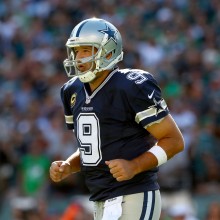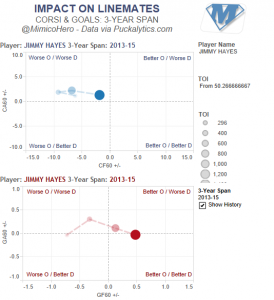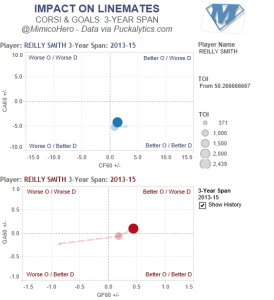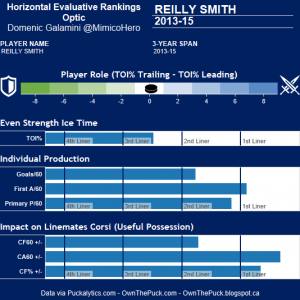Florida Panthers General Manager Dale Tallon avoided the free agent market July 1st but filled his time consummating a pact with the newly named GM of the Boston Bruins, Don Sweeney. Tallon relinquished unsigned restricted free agent Jimmy Hayes. In return, Sweeney shipped Reilly Smith to Florida only two seasons after his predecessor Peter Chiarelli acquired him from Dallas.
Hayes leaving was a sign that he didn’t fit in the long term plans for Florida (at least, at Hayes’ requested price point and term). Especially after speedier, higher quality power forward Lawson Crouse was drafted at 11th overall. Smith is signed for two years and is much better situated to be a longer term solution and though the details of this trade are old hat, fresh perspective can still be added by teasing out all the arteries splintering off of the deal.
Smith v. Hayes
Both right wingers were drafted relatively in the same spot (Hayes 60th overall in 2008 and Smith 69th in 2009), spent three years developing their game in the NCAA (Miami of Ohio for the Canadian Smith, Boston College for Massachusetts native Hayes), and in the last two NHL seasons deposited roughly the same amount of goals (33 for Smith, 31 for Hayes albeit with an imbalance of games played).
Just the same, that is where the similarities seem to stop. Hayes’ offensive production is heavily tilted towards goals – frequently having more goals than assists. That is untrue for Smith despite hitting the 20 goal mark two years ago in his first full professional season.
After the trade Tallon remarked, “Reilly…adds skill, speed and versatility to our team,” implying these as differentiators of the traded pair’s games (Florida Panthers, 2015).
On the surface, this holds up. Hayes brought a goal scoring touch but struggled to contribute in other ways, occasionally benched because of wildly inconsistent play (on both a game-by-game and shift-by-shift basis). Smith, despite being the 20 goal scorer of the two, faced more rigid defensive assignments on a line with Patrice Bergeron and marked his defensive assignments with aplomb.
Drilling deeper into the underlying stats, courtesy of Domenic Galamini (@MimicoHero), Smith’s skill set fosters linemate success in a way Jimmy Hayes was unable to do.
The top graph, in blue, shows the Corsi For (Shot Attempts For) per 60 minutes of ice time plus/minus (CF60 +/-) plotted against the Corsi Against (Shots Attempts Against) per 60 minutes of ice time plus/minus (CA60 +/-). The bottom graph, in red, shows the Goals For per 60 minutes of ice time plus/minus (GF60 +/-) plotted against the Goals Against per 60 minutes of ice time plus/minus (GA60 +/-).
Let’s dissect the bottom, red, graph first. Hayes is trending down – in a good way, as bottom right is the best quadrant to be in. Smith had a similar impact to Hayes last year (the biggest, darkest dot is the most current year) but is trending in the wrong direction. This may be affected by the difference in ZS%Rel over the past two seasons (Offensive Zone Start Percentage Relative to Team). This metric takes the percentage difference of shifts started in the offensive zone of the player to the team average. In the last two years, Smith had a ZS%Rel of 0.24 and Hayes had a ZS%Re. of 3.71, a much higher percent of shifts starting in the offensive zone (courtesy of War on Ice).
But before we put too much stock in the bottom graph, let us remember that past Corsi numbers hold more weight in predicting future success than past goal numbers and check out the top graph.
The Corsi event blue graph shows a much different story. Smith has stayed, roughly, in the same spot all three seasons. Here, Hayes is again trending in the right direction but is much further behind Smith’s pace. As far as shot attempts go, Reilly Smith is better in both ends of the ice. Moving forward, Smith’s contribution to puck possession is likely to help him surpass Hayes’ goal production.
Another visual from Galamini shows goals and Corsi in the context of line denotation, and highlights Smith’s projection outperform Hayes.
Both forwards have seen bottom six minutes over the same span of time, but it is Smith who shows a greater impact from those minutes, besting Hayes in six of the seven categories. Even with a more expensive contract over a shorter term, Smith still holds the edge. His all around contribution outside of their similar primary point production lifts his value over Hayes.
Smith’s Style in Sunrise
How does that added versatility fit with and help the Florida Panthers? I’m glad you asked…
We have all heard the old adage, “a coach is only as good as the players he is given” and to a certain extent, this is accurate. A coach’s philosophy, strategy, and usage is directly impacted by his roster. Taken to a more granular level (one that fits our cause), a coach gets more ‘miles’ out of a versatile winger than a more one-dimensional winger.
With the game broken down into a multitude of situations (power play, penalty kill, offensive zone, defensive zone, trailing, tied, and leading), it makes sense a coach will give more ice time to the winger who can play in the majority of the situations versus the winger who can only play in a few.
This logic comes into play when line construction is considered. Typically, player roles are divided across the top three lines. It is rare for coaches to roll out a line of three playmakers or three shooters. They chose to spread out these player types to create better line chemistry and a more well rounded lineup.
If we look at the Panthers’ young forward core from last year (Huberdeau, Barkov, Bjugstad, and Pirri) you can see the case for versatility. If placed on Huberdeau and Barkov’s line, Smith can tap into his 20 goal ability and become a more active shooter. Added to Bjugstad and Pirri’s line (a most likely destination) Smith becomes more of a set-up man to shooters Pirri and Bjugstad.
A change in coaching philosophy that was noticeable from the Dineen and Horachek teams to the Gallant team last year was the focus on rolling all four lines. This places less of a reliance on line matching and more on the overall talent of the roster. The speed and fluidity of the game (which exponentially increases every year with the furthering of player development and skills) makes it unrealistic to give major minutes to one dimensional players if they lack top end production.
Forwards are expected to be able to adjust on the fly to the line on the ice against them. One shift they may play a more shutdown game versus a top line, the next shift they may step up their offensive tempo to try to cash in on a weaker line. Players who lag behind stay off the ice.
This led to a lot of healthy scratches for Jimmy Hayes, who was unable to adapt to Gallant’s coaching over the course of the year. With Hayes, his style failed to mesh with the overall forward group and philosophical direction of the team. While Hayes moves well for a player his size, through the neutral zone he was unable to move with the necessary speed on regroup and transition plays.
His neutral zone troubles had less to do with his foot speed and more to do with his puck speed. Quick puck movement is a pillar of Gallant’s systems in all three zones. Hayes’ hesitation with the puck was more a mix of slower game processing ability (i.e. Hockey IQ) and lesser passing skills than his linemates. Soft hands are required to quickly catch and release passes under the jumping forechecking pressure. Though Hayes had good hands in front of the net that skill set never translated away from the opposing crease. Hayes’ inability to consistently produce and force Gallant to use him more, kept Hayes at the bottom of the TOI list and without the versatility in his game, he was unable to gain additional ice time in non-scoring situations.
In Boston, Smith had his best year with Patrice Bergeron and Brad Marchand, a line consistently used to match up against top units. Though more sheltered than Bergeron or Marchand and left off the penalty kill, Bruins coach Claude Julien showed trust in Smith’s defensive game. Smith’s versatility was also tested in Boston by sliding up and down the lineup over the course of last year as the Bruins struggled to find chemistry. Without PK time, Smith handled those assignments well but how he produces when given devoted penalty kill time has yet to be seen.
Gallant may test that early this year, as Smith has the ability to kill penalties and the Panthers will be looking to find promising volunteers with shorthanded skaters Tomas Kopecky and Scottie Upshall leaving to free agency. If Smith can carve out a niche on the PK with Barkov (who should see an increased role) or another center, Smith can easily add value where Hayes could not.
Smith Situated to Supersede Jokinen?
Thinking back on Tallon’s remarks following the Smith-for-Hayes deal, noticeable is the value of versatility in this trade for the Panthers. Tallon was hunting for it. This type of versatility beckons shades of a similarly useful winger, Jussi Jokinen.
Jussi Jokinen is Florida’s resident Swiss Army Knife. Playing in any situation, on every line, and lining up as both a winger and center, Jokinen earned his $4 million salary last year. However, with three seasons left (including this year), maybe Tallon smartly is getting a jump start filling Jussi’s shoes.
Should Smith emerge as a reliable member of Florida’s top six, Tallon has the option to aid an ailing position of his team, or the farm system, by moving Jussi and his $4 million dollars out. Jokinen has the third highest cap hit of the forwards (as we continue to ignore Marc Savard). Not only are Aleksander Barkov, Jaromir Jagr (He will never retire at this rate), Brandon Pirri, and Vincent Trocheck due new contracts next year but Kyle Rau, Jayce Hawryluk, Rocco Grimaldi, and Connor Brickley are pushing for spots. Moving Jokinen could provide the spot and money needed to keep everyone around.
That wasn’t the case last winter when Tallon was forced into trading Colby Robak and Drew Shore. Both Robak and Shore grew impatient and Tallon didn’t have the space in the NHL to give, necessitating the December and January trades.
Those were the first two casualties of prospect excess. Tallon remains calm, cycling out free agent vets and declining players like clockwork. His hardest test was letting fan favorite Stephen Weiss leave town. Weiss shouldn’t take it personal. Upshall, Kopecky, Tomas Fleischmann, Sean Bergenheim, Brad Boyes, Ed Jovanovski, Scott Clemmensen, Marcel Goc, Jason Garrison, Filip Kuba, and Jose Theodore all were either let go, bought out, or moved out in the last year of their contracts. And here we are today with Dmitri Kulikov, the lone representative of the pre-Tallon NHL roster.
Applying a stronger lens to the addition of Smith, you can see Tallon’s overarching plan. Add goals and winger depth to compete for playoffs whilst the young Cats coming up gain their footing, consistently trim the roster to allow organic roster turnover, and acquire complementary players to the team’s drafted core players.
Hayes and Jokinen will be/are replaced by Crouse and Smith, in a staggered timeframe, showcasing Tallon’s ‘big picture’ planning. The next wave of prospects are ready to make the jump, and depending on their progress and maturation, Tallon can afford to part ways with Jokinen if need be. A strong training camp by Kyle Rau, Lawson Crouse, or Connor Brickley could force Tallon’s hand before Thanksgiving. It’s not like Tallon is scared to be assertive in the trade market early.
Whyhockey can be reached for contact on Twitter.
























